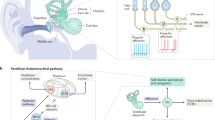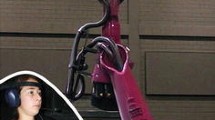Summary
Human subjects continuously estimated their position during and after steps of angular acceleration in complete darkness. These estimations were compared with the same vestibular stimulation in the light while subjects gazed at a striped cylinder which completely enclosed them and was mechanically fixed to the turntable. Rotation with such a fixed visual surround created a sensory conflict: the acceleration is sensed by the vestibular end organs, while the visual system senses no displacement. Accordingly, during the conflict stimulation, the estimation of rotational velocity and its duration is markedly reduced. These findings in humans compare well with nystagmus and single neuron recordings in the vestibular nuclei of alert monkeys.
Zusammenfassung
Versuchspersonen gaben kontinuierlich ihren Drehwinkel während und nach Winkelbeschleunigungen in völliger Dunkelheit an. Anschließend wurden die Versuchspersonen mit den gleichen Parametern im Hellen gedreht, wobei sie von innen auf eine gestreifte Trommel blickten, die den Drehstuhl vollständig umgab und mit ihm rotierte. Dies provozierte einen sensorischen Konflikt: während bei Beschleunigungen über das vestibuläre Endorgan eine Drehung gemeldet wird, wird visuell keine Bildverschiebung gesehen. Entsprechend sind bei der Konfliktreizung Dauer und Größe der Geschwindigkeitsschätzung herabgesetzt. Diese Ergebnisse entsprechen gut Messungen von Nystagmus und Einzelzellaktivität in den vestibulären Kernen bei wachen Affen, die unter identischen Versuchsbedingungen getestet wurden.
Similar content being viewed by others
References
Clark, B., Stewart, J. P.: Comparison of angular sensitivity for the perception of bodily rotation and the oculogyral illusion. Percept. Psychophys. 3, 253–256 (1968)
Dichgans, J., Brandt, Th.: The psychophysics of visually induced perception of self-motion and tilt. In: The neurosciences, F. O. Schmidt, F. G. Worden (eds.), pp. 123–129. Cambridge, Mass.: MIT Press 1974
Dichgans, J., Brandt, Th.: Visual-vestibular interaction. Effects on self-motion perception and postural control. In: Handbook of sensory physiology, R. Held, H. Leibowitz, H. L. Teuber (eds.), Vol. VIII, pp. 755–804. New York: Springer 1978
Fischer, M. H., Kornmüller, A. E.: Optokinetisch ausgelöste Bewegungswahrnehmungen und optokinetischer Nystagmus. J. Psychol. Neurol. 41, 273–308 (1930)
Graybiel, A., Hupp, D. I.: The oculogyral illusion: a form of apparent motion which may be observed following stimulation of the semicircular canals. J. Aviat. Med. 17, 3–27 (1946)
Huang, J.: Visual field influence on motion sensation in yaw and on manual roll stabilization. FM Thesis, Dept. of Aeronautics and Astronautics, M.I.T., Cambridge, Mass. (1979)
Koenig, E., Allum, J. H. J., Dichgans, J.: Visual-vestibular interaction upon nystagmus slow phase velocity in man. Acta Otolaryngol. (Stockh.) 85, 397–410 (1978)
Mach, E.: Grundlinien der Lehre von den Bewegungsempfindungen. Leipzig: W. Engelmann 1875; Amsterdam: Bonset 1967
Marshall, J. E.: Visual-vestibular interaction and threshold for angular acceleration. USAMRL, Fort Knox, KY, Report 754 (1967)
Meiry, J. L.: The vestibular system and human dynamic space orientation. Sc. D. Thesis, MIT, Cambridge, MA (1965)
Raphan, T., Cohen, B., Matsuo, V.: A velocity-storage mechanism responsible for optokinetic nystagmus (OKN), optokinetic afternystagmus (OKAN) and vestibular nystagmus. In: Control of gaze by brain stem neurons, R. Baker, A. Berthoz (eds.), pp. 37–47. Amsterdam: Elsevier-North Holland 1977
Robinson, D. A.: Vestibular and optokinetic symbiosis: an example of explaining by modeling. In: Control of gaze by brain stem neurons, R. Baker, A. Berhoz (eds.), pp. 49–58. Amsterdam: Elsevier-North Holland 1977
Travis, R. C.: Reciprocal inhibition and reenforcement in the visual and vestibular systems. J. Exp. Psychol. 12, 415–430 (1929)
Waespe, W., Henn, V.: Conflicting visual-vestibular stimulation and vestibular nucleus activity in alert monkeys. Exp. Brain Res. 33, 203–211 (1978)
Waespe, W., Henn, V.: The velocity response of vestibular nucleus neurons during vestibular, visual, and combined angular acceleration. Exp. Brain. Res. 37, 337–347 (1979)
Young, L. R., Dichgans, J., Murphy, R., Brandt, Th.: Interaction of optokinetic and vestibular stimuli in motion perception. Acta Otolaryngol. (Stockh.) 76, 24–31 (1973)
Zaccharias, G. L., Young, L. R.: Influence of combined visual and vestibular cues on human perception and control of horizontal rotation. Exp. Brain Res. (in press, 1980)
Author information
Authors and Affiliations
Rights and permissions
About this article
Cite this article
Waespe, B., Waespe, W. & Henn, V. Subjective velocity estimation during conflicting visual-vestibular stimulation. Arch. Psychiat. Nervenkr. 228, 109–116 (1980). https://doi.org/10.1007/BF00365599
Received:
Issue Date:
DOI: https://doi.org/10.1007/BF00365599




